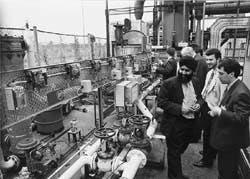ADVANCED TECHNOLOGY
Leonard LeBlanc
Houston
BP and 26 instrumentation companies will shortly provide results from Phase II field trials of the new fieldbus system, which features closed loop control and monitoring. The fieldbus system, which can link virtually all offshore platform functions, is shown in trials here at Sunbury-on-Thames in the UK.
- Storms at sea produce a footprint marked by a core area, where waves are damped by falling rain, surrounded by a highly active zone. This footprint is visible on satellite synthetic aperture radar, along with the strength of the rainfall and winds surrounding the core. More information on these measurements can be obtained from David Atlas, Goddard Space flight Center, Greenbelt, Maryland.
Analysis shows dual hulls less efficient than tug stationing
In terms of preventing major environmental disasters, the stationing of tugs in areas of high risk along the UK coastline is more effective than double hulling of tankers. This is the result of risk analysis performed by a DnV Technica risk assessment program applied to crude tanker traffic in UK waters.
The program could be applied to other areas of the world, and the developers believe the results could be the same in many other high traffic areas. The risk system is known as MARCS, for marine accident risk calculation system.
Risk control measures such as traffic routes and frequency, lane locations and widths, cargo types, service zones, coastline geography and geology, area meteorology and visibility, presence of platforms and islands, tug availability, and vessel design features are all assessed and ranked. The factors are used to evaluate the cost-benefit ratio of different risk control measures.
The system determined that a double hull tanker fleet operating in UK waters would reduce the frequency of small spills by a significant 58%. However, the frequency of catastrophic spills would be reduced by only 8%.
In contrast, the stationing of tugs at specific areas along the coastline would reduce the frequency of catastrophic losses among single hull tankers, although they would not be as effective for small spills. The reason for this result is that drift grounding events are the type of accidents most likely to cause catastrophic losses, regardless of whether the hull is single or double. Tugs can prevent grounding accidents, if they are available when and where needed. Hence, the attraction of tug stationing.
The results of this risk analysis were included in a technical paper (OSEA-94076) presented by DnV Technica at the Offshore Southeast Asia conference in November 1994. The presenter observed that while the mandated use of double hull tankers is a direct cost to the petroleum industry, the positioning of tugs around the coastline is generally a cost shouldered by government. Thus, governments generally will favor solution costs that impact industry.
Cargo vessels undergoing major hull re-design
A Finnish design and fabrication yard is about to launch a 738 ft long cargo vessel characterized by two advances over conventional designs - 50-60% greater ocean speeds and one-half the time for roll-on, roll-off loading. Kvaerner Masa-Yards of Turku, Finland is building the vessel.
The vessel's bow resembles the sloped front of a high speed train, with the bridge at the top of the slope. The hull resembles a long slender tube shaped like an airplane fuselage. The 738-ft-long vessel will have a cruising speed of 30 knots, compared with the 15-20 knots of conventional cargo vessels.
The design efficiencies of the new vessel are as follows:
- Displacement:A displacement-type design proved more efficient than air cushion, hydrofoil or other similar hull shapes. Displacement hulls required less power to attain greater speeds than competing designs when displacements exceeded 2,000 tons. The power cost to lift the hull into a planing position was too great.
- Single hull: A monohull design was considered more efficient than catamaran and trimaran units. A slender monohull design posed less resistance for higher displacements, and the power requirement was less than the other two designs.
- Narrow bow: A wave-piercing bow design was picked over broader bow forms. The cost here was a smaller payload in the bow, but there were countering advantages. In addition to higher speeds, the vessel's gas turbine generators were moved from midships to the bow spaces, allowing for more cargo there.
- Weight: The vessel is 20% lighter than conventional vessels, allowing for a doubling of payload. To obtain the lighter weight, the hull is constructed of high-tensile steel, and the crew quarters in the open deck area are made of fiberglass. No assistance:Tugs are not required for docking because of the twin propellers and rudders at the rear and bow thrusters forward.
The vessel design may be copied by other fabricators for offshore oil industry functions, especially where displacement and cargo capacity are involved.
Copyright 1995 Offshore. All Rights Reserved.

